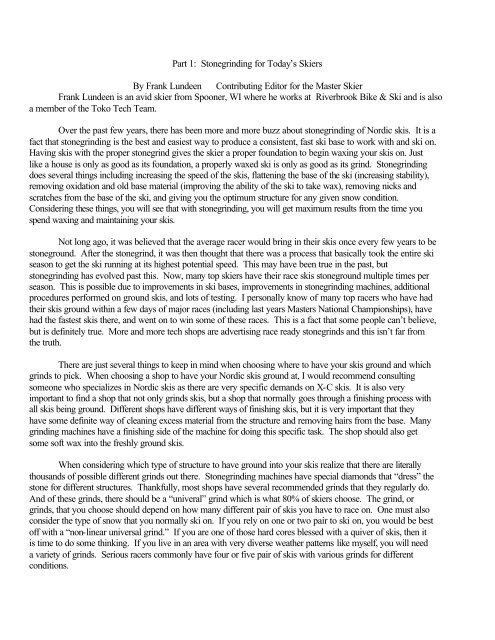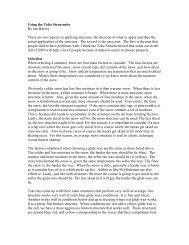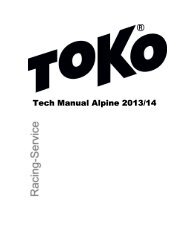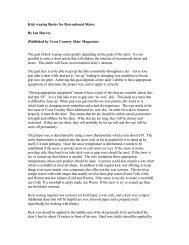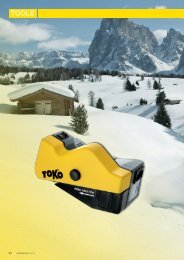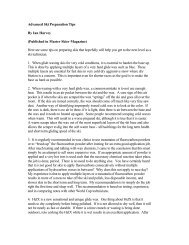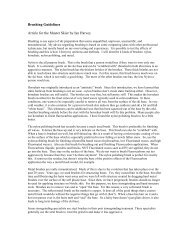Part 1: Stonegrinding for Today's Skiers By Frank Lundeen ... - Toko
Part 1: Stonegrinding for Today's Skiers By Frank Lundeen ... - Toko
Part 1: Stonegrinding for Today's Skiers By Frank Lundeen ... - Toko
Create successful ePaper yourself
Turn your PDF publications into a flip-book with our unique Google optimized e-Paper software.
<strong>Part</strong> 1: <strong>Stonegrinding</strong> <strong>for</strong> Today’s <strong>Skiers</strong><br />
<strong>By</strong> <strong>Frank</strong> <strong>Lundeen</strong> Contributing Editor <strong>for</strong> the Master Skier<br />
<strong>Frank</strong> <strong>Lundeen</strong> is an avid skier from Spooner, WI where he works at Riverbrook Bike & Ski and is also<br />
a member of the <strong>Toko</strong> Tech Team.<br />
Over the past few years, there has been more and more buzz about stonegrinding of Nordic skis. It is a<br />
fact that stonegrinding is the best and easiest way to produce a consistent, fast ski base to work with and ski on.<br />
Having skis with the proper stonegrind gives the skier a proper foundation to begin waxing your skis on. Just<br />
like a house is only as good as its foundation, a properly waxed ski is only as good as its grind. <strong>Stonegrinding</strong><br />
does several things including increasing the speed of the skis, flattening the base of the ski (increasing stability),<br />
removing oxidation and old base material (improving the ability of the ski to take wax), removing nicks and<br />
scratches from the base of the ski, and giving you the optimum structure <strong>for</strong> any given snow condition.<br />
Considering these things, you will see that with stonegrinding, you will get maximum results from the time you<br />
spend waxing and maintaining your skis.<br />
Not long ago, it was believed that the average racer would bring in their skis once every few years to be<br />
stoneground. After the stonegrind, it was then thought that there was a process that basically took the entire ski<br />
season to get the ski running at its highest potential speed. This may have been true in the past, but<br />
stonegrinding has evolved past this. Now, many top skiers have their race skis stoneground multiple times per<br />
season. This is possible due to improvements in ski bases, improvements in stonegrinding machines, additional<br />
procedures per<strong>for</strong>med on ground skis, and lots of testing. I personally know of many top racers who have had<br />
their skis ground within a few days of major races (including last years Masters National Championships), have<br />
had the fastest skis there, and went on to win some of these races. This is a fact that some people can’t believe,<br />
but is definitely true. More and more tech shops are advertising race ready stonegrinds and this isn’t far from<br />
the truth.<br />
There are just several things to keep in mind when choosing where to have your skis ground and which<br />
grinds to pick. When choosing a shop to have your Nordic skis ground at, I would recommend consulting<br />
someone who specializes in Nordic skis as there are very specific demands on X-C skis. It is also very<br />
important to find a shop that not only grinds skis, but a shop that normally goes through a finishing process with<br />
all skis being ground. Different shops have different ways of finishing skis, but it is very important that they<br />
have some definite way of cleaning excess material from the structure and removing hairs from the base. Many<br />
grinding machines have a finishing side of the machine <strong>for</strong> doing this specific task. The shop should also get<br />
some soft wax into the freshly ground skis.<br />
When considering which type of structure to have ground into your skis realize that there are literally<br />
thousands of possible different grinds out there. <strong>Stonegrinding</strong> machines have special diamonds that “dress” the<br />
stone <strong>for</strong> different structures. Thankfully, most shops have several recommended grinds that they regularly do.<br />
And of these grinds, there should be a “univeral” grind which is what 80% of skiers choose. The grind, or<br />
grinds, that you choose should depend on how many different pair of skis you have to race on. One must also<br />
consider the type of snow that you normally ski on. If you rely on one or two pair to ski on, you would be best<br />
off with a “non-linear universal grind.” If you are one of those hard cores blessed with a quiver of skis, then it<br />
is time to do some thinking. If you live in an area with very diverse weather patterns like myself, you will need<br />
a variety of grinds. Serious racers commonly have four or five pair of skis with various grinds <strong>for</strong> different<br />
conditions.
• Commonly after we get big snow falls, the temperature drops dramatically. Because of this, one<br />
should have a pair of good soft pack skis with a cold grind. We have had phenomenal success<br />
with this combo here in the Midwest.<br />
• A pair of soft pack to medium skis should be selected <strong>for</strong> a wet corn snow grind.<br />
• A medium to hard pack ski should be selected <strong>for</strong> a linear grind. The linear grind excels in corn<br />
snow, man-made snow, or fresh wet snow.<br />
• The most important grind to have in your quiver, the universal grind should be on a pair of soft<br />
pack skis and a pair of hard pack skis <strong>for</strong> normal (10’F to 30’F untrans<strong>for</strong>med snow conditions).<br />
With this array of grinds, one will be prepared <strong>for</strong> virtually any snow condition. Obviously, when you<br />
figure out the weather and snow conditions <strong>for</strong> your event, most of these different options will be ruled out.<br />
Just choose the skis with the appropriate structures and prepare and test those one or two pairs.<br />
Now that your skis are ground, what are you to do? There are several things you can do to ensure that<br />
your skis will be rocket ships the first time on snow. Be<strong>for</strong>e you start working on your skis, refresh your<br />
memory on proper waxing technique as this is often more important than the wax you choose to use. Another<br />
thing to note is to make sure to have a very sharp plexi-scraper. Having a sharp plexi-scraper will ensure that<br />
you cut off any remaining hairs on your ski base and will work much better <strong>for</strong> scraping. I recommend<br />
following these guidelines to achieve optimum ski speed the first time out…<br />
1. Scrape and brush out the layer of wax the shop put on your skis after the grind.<br />
2. Using a copper brush, brush the ski using long strokes from tip to tail. This will help stand any hairs<br />
on your base on end. The copper brush will not create miro-hairs.<br />
3. Now we will be per<strong>for</strong>ming the hot scrape. When hot scraping, use a soft wax. Apply it. While the<br />
wax is still warm, scrape off the wax using your plexi scraper. Make sure to use long, smooth<br />
strokes from tip to tail with the plexi-scraper. Begin brushing out the ski immediately with the<br />
copper brush, using long strokes from tip to tail. (You should only use the copper brush <strong>for</strong> brushing<br />
out wax when per<strong>for</strong>ming the hot scrape.) Finish brushing with the nylon brush and finally<br />
horsehair brush.<br />
4. It is very important to get several coats of a soft paraffin wax into the ski leaving each coat cool<br />
be<strong>for</strong>e scraping and brushing.<br />
5. After several coats of soft wax, it is best to get a variety of hard and soft waxes into the ski base.<br />
Fantastic results can be achieved by alternating hard to soft wax. <strong>By</strong> doing this, you will actually<br />
begin to harden the base of the ski producing a more durable base with the hard wax, yet get<br />
excellent wax penetration with the soft wax.<br />
6. Finally, move on to your wax of the day. You are well on your way to enjoying the fastest skis<br />
possible!<br />
Remember, waxing can be as simple or as complicated as you want to make it. It is important to work<br />
with a wax system that you are com<strong>for</strong>table with and simply match the snow conditions to your wax choice.<br />
Generally speaking, the more you wax your skis, the faster they will be. In many cases, just the stonegrind with<br />
a few coats of wax will dramatically increase the per<strong>for</strong>mance of your skis. Above all, don’t loose sight of the<br />
reason you love this sport, to enjoy skiing. Make sure to spend more time skiing than working on your skis and<br />
above all, THINK SNOW!!!


